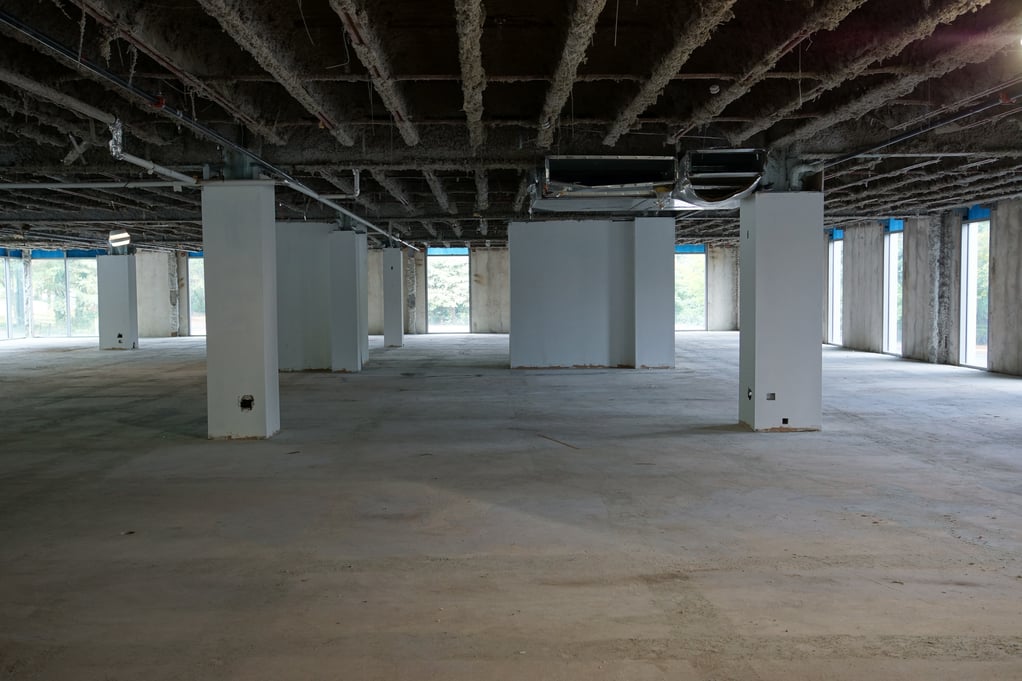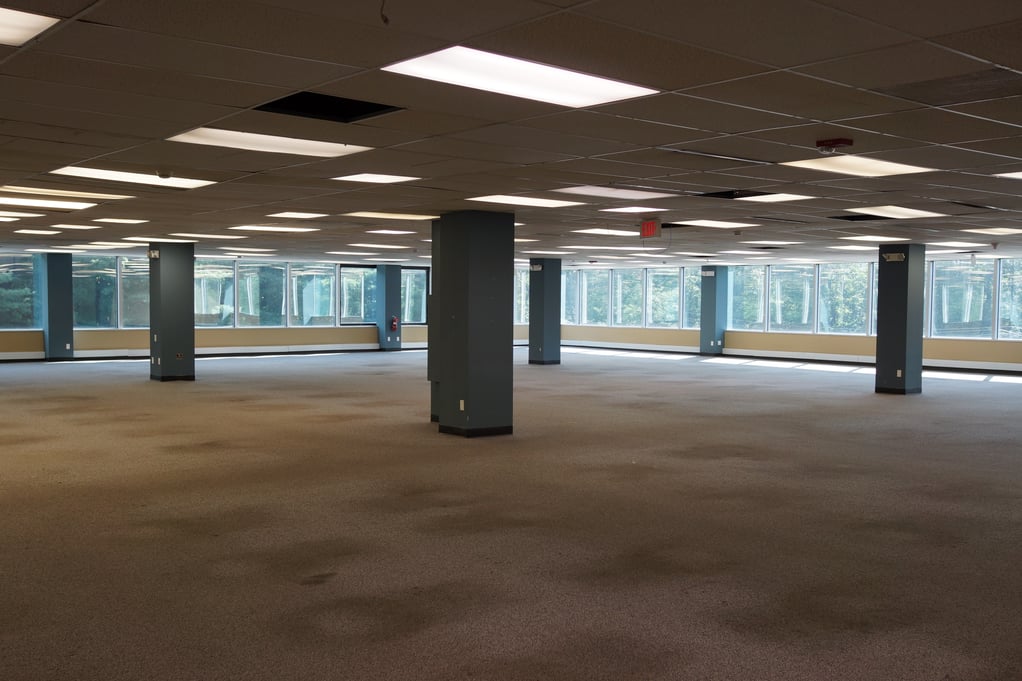In this article, you'll learn:
- Factors influencing the duration of an office build-out from lease execution to final construction
- Key elements of the work letter and its impact on renovation timelines and budgets
- The design phase and how construction drawings shape office space and cost estimates
- The role of building permits and approvals in the construction process
- Understanding different construction phases, from cold dark shells to warm lit shells, and their impact on build-out duration
We hate to be the bearers of bad news, but if you were looking for a hard and fast number, this is not that type of article. There’s a lot of factors that go into determining your office build-out’s timeline, and we’re here to dive into them so you can be fully prepared for everything the construction may throw your way.
Getting your office building to become an environment where your team can thrive can involve a somewhat lengthy process. So read on, you'll be more prepared for what comes after you find your dream office.
Lease Execution and Your Work Letter
By the time your lease is signed, you likely have an okay idea of how long potential renovations will take since the timeline is tied mostly to your building’s initial property condition. (And there should be no surprises because you should have toured the existing space in the site selection process).
But, regardless of the regardless of the shape your new leased property is in, the first stage of your build-out timeline should factor in negotiating the work letter. Factors established here will affect your office and tenancy for your entire stay, so don't go into negotiations unprepared. Learn Why You Should Never Negotiate Without a Representative.

The work letter is intended to cover any conditions that must be met during the newly leased space build-out process. The build-out clause is highly extensive and can often appear as its own document in addition to the lease. At a bare minimum, it should cover:
- The plans and expectations of the tenant
- Timelines for the build-out (including plans, approval dates, and construction schedule)
- Costs to be covered by the landlord (and possibly the tenant)
- Contractors conducting the work
- Building permit expectations
- Cost of the build-out
- Expected form and timeline of payments
- Work acceptance, possession, and occupancy
It provides critical protection to tenants by ironing out responsibilities and consequences should they not be met. Obviously, tenants with larger projects should expect a lengthier negotiation process. There are more details, contractors, and plans that needed to be pinned down, as opposed to just an aesthetic renovation.
Construction Drawings and Design
At this stage your landlord may have already had their architect complete a test-fit, single line drawing to see how well you fit in their space. Landlords commonly perform test fits for prospective tenants to provide estimated timelines and a potential schematic design of the floor plan.
Often, the landlord will have an in-house contractor, or their preferred person estimate the work to be completed and its cost including:
- Doors
- Framing studs
- Sheetrock
- Lighting
- Outlets
- Electric Wiring
- HVAC
- Millwork
- Floor coverings, etc.
Essentially, the design phase will transform the existing space according to your principal business needs. In design development though, some iteration is expected to determine your final space plans and how they fit into the workflow patterns of your staff.

After the precursory construction drawings, you should have a more nuanced understanding of how your company will occupy the office. The initial design will then be embellished with more detail. This information will become critical when determining interior features like furniture installation, heat load, location of outlets, and appropriate lighting. The final construction drawings should allow you to estimate construction costs.
It’s up to you whether you decide to work with the landlord’s team or your own design team on your new office, but some due diligence is required on your behalf to ensure that the bid you receive is actually the cost of the buildouts. Because the design process and eventual construction pricing will depend on the general contractor you work with.
Working with the design development team for an initial programming and space plans will likely take at least ~2 - 4 weeks.
Building Permit and Approval
Before the construction phase can begin, the completed construction drawings for the new office space must be approved. Like with negotiation, a more significant build-out should allot more time for the approval process.
If you’re starting from scratch on a build-to-suit, you have a lot more red tape to cross than refurbishing a second-generation office.
Regardless, any plans are usually subject to the approval of town councils like the local Building Department. They must ensure that the property intention will meet building permit specifications for factors like:
- Parking ratios
- Tenant footprint
- Property setbacks
- Maximum height and / or floors
- How much greenery should be present
- Water usage and sewage disposal
- The construction team
- The project's time frame
All said and done, this will really depend on your municipality and building plans. The process usually takes about 4-8 weeks, allowing for extreme variability with this schedule according to the practices of local municipalities. If your files are not in order, you can potentially experience significant delays on this end. That is why it is so critical to work with a representative of your own.
To sum it all up, the following is for our visual learners, outlining the stages leading to construction.

Office Space Construction
You know how construction work is notoriously always finished on time? Yeah, we don’t either. Not that you should expect delays, but in reality, they’re quite common when it comes to build-outs. The key is allowing yourself a window of time for renovations to be completed, allotting for possible setbacks. That way it won’t fully derail your plans to occupy the office (while causing extreme monetary and productivity losses).
Also, if delays do take place, make sure you have safeguards in your lease that protect your interests in this case.
Truly though, the main factor in determining your timeline is the building’s initial state. Depending on how move-in-ready it is, you could be looking at months of renovations. For example, if you find a property that requires a more extensive build-out like shell condition spaces, there is more room for delays in the construction process.
That being said, construction will obviously take longer in general for first-gen buildouts. Second generation space that another tenant previously inhabited may require less work depending on what the tenant wants. For example, a new tenant may come along and wish to gut the existing space and start from scratch. Still, at least the major ductwork, ceiling, outer walls, etc., will already be in place.
On the other hand, if you are moving into mostly unfinished, virgin space, your building will likely be presented in a cold dark shell condition. While the exact features will vary from building to building, shell space denotes that construction has been completed but there are few fixtures, if any. But we’ll go a bit deeper on this below.
Green Site / Shovel-Ready / Build to Suit
If you’re signing a lease for either of these conditions, you know you’re in it for the long-haul. Either the ground has been broken for construction or the land has been claimed for the purpose of building an office.

You may very well be starting with a dirt or green lot (hence the name). Therefore, depending on whether zoning and permits have been accepted, you know you’re likely facing a long construction process. Then, depending on the size and scope of your project, a build-out of these property conditions can potentially take several months to even years.
Therefore, timing can be difficult to line up with the end of an existing lease.
Cold Dark Shell
A cold dark shell is effectively the building’s skeleton state. It is also the barest condition shell spaces can be presented in. No HVAC, no lights, no ceiling, no flooring. It’s just:
- 4 Walls
- A roof
- Unfinished flooring
Cold, dark shells give the tenant great flexibility to adapt the space to their needs. However, as you can imagine, this form requires the most renovations, time, and the most upfront expenses. As a result, the starting point for rent prices will likely be lower.

A word to the wise: The caveat with a shell space build out, is that if the tenancy starts at a cold, dark shell, you will need to negotiate for a much higher tenant improvement allowance since a good part of it is going toward making a warm, lit shell, even before the real work of your office space begins.
|
You never want construction costs to eat away at your TI offer while the landlord benefits because the space is more habitable when you leave. |
From design to completion of construction for cold dark shell space, it potentially may take up to eight months.
Warm Lit Shell
Either the office is second generation space or isn’t, but a warm, vanilla shell space is more ready for tenants to move in. Less build out work is required of the tenant before they can occupy the space. Standard fixtures are either already there from an older tenant or the landlord conducted an initial build out to market the space.
Warm, vanilla shells are typically equipped with:
- Ceiling
- Lighting
- Interior has a basic finish
- Plumbing
- HVAC
- May have painted walls
- Electrical outlets
- Restrooms
- Concrete or finished flooring
Typically, the work completed are any aesthetic renovations, updates from old tenants, or anything to transform the building beyond standard. Depending on the state of this shell space, expect up to potentially 5 months.

Plan Your Build Out with a Tenant Representative
If you're looking for new space, or you just want your old space to feel like new, you should work with a True Tenant Rep™. From the building search to the design phase to ensuring your business continues uninterrupted by construction delays, a True Tenant Rep™ is an invaluable asset to have by your side.
They will work with your project team, establishing thorough communication to ensure your office fit properly accommodates your business' needs. They also know that your Tenant Improvement Allowance should be largely determined by how extensive the build out process is. So, they will leverage your building's state and the value of your tenancy to get the best deal possible for any unfinished space.
Not only will they save you time in the negotiation process but could take millions off the total cost of your lease. So, whether the building you're looking at a shell condition space, second generation space, dirt lot, or anything in between- you can rest easy knowing you'll get the best deal for your new space.
Learn more about your Tenant Improvement Allowance.
Talk to a True Tenant Rep™ at iOptimize Realty™ today.








